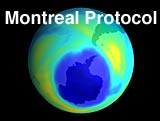![]()
|
|

Planning meeting in China for the solvents sector phase-out programme. |
The Montreal Protocol
The Vienna Convention and the Montreal Protocol In 1985, scientific concerns about damage to the ozone layer prompted governments to adopt the Vienna Convention on the Protection of the Ozone Layer (Adobe PDF), which established an international legal framework for action. Then, two years later, in 1987, international negotiators met again to adopt legally binding commitments in the Montreal Protocol on Substances that Deplete the Ozone Layer, which required industrialized countries to reduce their consumption of chemicals harming the ozone layer. During the evolution of it's implementation, as a result of changing
conditions and increased information, additional requirements have been
added to the Montreal Protocol through amendments adopted in London
(1990), Copenhagen
(1992), Montreal
(1997) and Beijing
(1999). Phase-Out Targets As of September 2002, 183 countries have ratified the Montreal Protocol which sets out the time schedule to "freeze" and reduce consumption of ozone depleting substances (ODS). The Montreal Protocol requires all Parties to ban exports and imports of controlled substances to and from non-Parties. Production and consumption of CFCs, halons and other ozone depleting chemicals have been phased out in industrialized countries and a schedule is in place to eliminate the use of methyl bromide, a pesticide and agricultural fumigant. Developing countries (Article 5 Parties) operate under different phase-out schedules, having been given a grace period before phase-out measures would apply to them, in recognition of their need for industrial development and their relatively small production and use of ODS. Developing countries have agreed to freeze most CFC consumption as of 1 July 1999 based on 1995-97 averages, to reduce this consumption by 50% by 1 January 2005 and to fully eliminate these CFCs by 1 January 2010. Other control measures apply to ODS such as halons, carbon tetrachloride and methyl chloroform. For methyl bromide, used primarily as a fumigant, developed countries froze their consumption at 1995 levels and will eliminate all use by 2010, while developing countries have committed to freeze consumption by 2002 based on average 1995-98 consumption levels. Control Measures of the Montreal Protocol
|
|||||||||||||||||||||||||||||||||||||||||||||